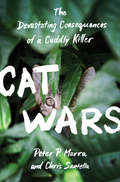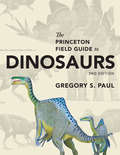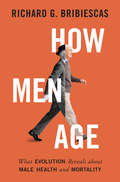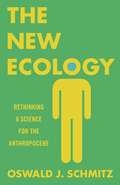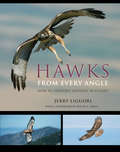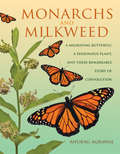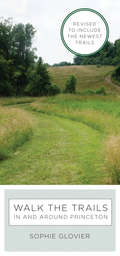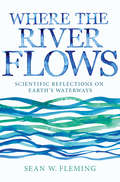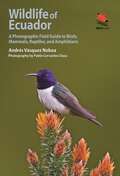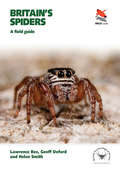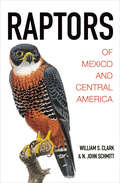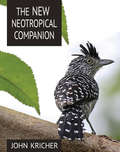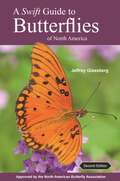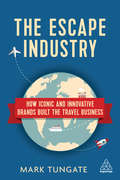- Table View
- List View
Pursuing Sustainability: A Guide to the Science and Practice
by Pamela Matson William C. Clark Krister AnderssonSustainability is a global imperative and a scientific challenge like no other. This concise guide provides students and practitioners with a strategic framework for linking knowledge with action in the pursuit of sustainable development, and serves as an invaluable companion to more narrowly focused courses dealing with sustainability in particular sectors such as energy, food, water, and housing, or in particular regions of the world.Written by leading experts, Pursuing Sustainability shows how more inclusive and interdisciplinary approaches and systems perspectives can help you achieve your sustainability objectives. It stresses the need for understanding how capital assets are linked to sustainability goals through the complex adaptive dynamics of social-environmental systems, how committed people can use governance processes to alter those dynamics, and how successful interventions can be shaped through collaborations among researchers and practitioners on the ground.The ideal textbook for undergraduate and graduate students and an invaluable resource for anyone working in this fast-growing field, Pursuing Sustainability also features case studies, a glossary, and suggestions for further reading.Provides a strategic framework for linking knowledge with actionDraws on the latest cutting-edge science and practicesServes as the ideal companion text to more narrowly focused coursesUtilizes interdisciplinary approaches and systems perspectivesIllustrates concepts with a core set of case studies used throughout the bookWritten by world authorities on sustainabilityAn online illustration package is available to professors
Cat Wars: The Devastating Consequences of a Cuddly Killer
by Peter P. Marra Chris SantellaIn 1894, a lighthouse keeper named David Lyall arrived on Stephens Island off New Zealand with a cat named Tibbles. In just over a year, the Stephens Island Wren, a rare bird endemic to the island, was rendered extinct. Mounting scientific evidence confirms what many conservationists have suspected for some time—that in the United States alone, free-ranging cats are killing birds and other animals by the billions. Equally alarming are the little-known but potentially devastating public health consequences of rabies and parasitic Toxoplasma passing from cats to humans at rising rates. Cat Wars tells the story of the threats free-ranging cats pose to biodiversity and public health throughout the world, and sheds new light on the controversies surrounding the management of the explosion of these cat populations.This compelling book traces the historical and cultural ties between humans and cats from early domestication to the current boom in pet ownership, along the way accessibly explaining the science of extinction, population modeling, and feline diseases. It charts the developments that have led to our present impasse—from Stan Temple's breakthrough studies on cat predation in Wisconsin to cat-eradication programs underway in Australia today. It describes how a small but vocal minority of cat advocates has campaigned successfully for no action in much the same way that special interest groups have stymied attempts to curtail smoking and climate change.Cat Wars paints a revealing picture of a complex global problem—and proposes solutions that foresee a time when wildlife and humans are no longer vulnerable to the impacts of free-ranging cats.
Cat Wars: The Devastating Consequences of a Cuddly Killer (PDF)
by Peter P. Marra Chris SantellaIn 1894, a lighthouse keeper named David Lyall arrived on Stephens Island off New Zealand with a cat named Tibbles. In just over a year, the Stephens Island Wren, a rare bird endemic to the island, was rendered extinct. Mounting scientific evidence confirms what many conservationists have suspected for some time—that in the United States alone, free-ranging cats are killing birds and other animals by the billions. Equally alarming are the little-known but potentially devastating public health consequences of rabies and parasitic Toxoplasma passing from cats to humans at rising rates. Cat Wars tells the story of the threats free-ranging cats pose to biodiversity and public health throughout the world, and sheds new light on the controversies surrounding the management of the explosion of these cat populations.This compelling book traces the historical and cultural ties between humans and cats from early domestication to the current boom in pet ownership, along the way accessibly explaining the science of extinction, population modeling, and feline diseases. It charts the developments that have led to our present impasse—from Stan Temple's breakthrough studies on cat predation in Wisconsin to cat-eradication programs underway in Australia today. It describes how a small but vocal minority of cat advocates has campaigned successfully for no action in much the same way that special interest groups have stymied attempts to curtail smoking and climate change.Cat Wars paints a revealing picture of a complex global problem—and proposes solutions that foresee a time when wildlife and humans are no longer vulnerable to the impacts of free-ranging cats.
The Princeton Field Guide to Dinosaurs: Second Edition
by Gregory S. PaulThe best-selling Princeton Field Guide to Dinosaurs remains the must-have book for anyone who loves dinosaurs, from amateur enthusiasts to professional paleontologists. Now extensively revised and expanded, this dazzlingly illustrated large-format edition features some 100 new dinosaur species and 200 new and updated illustrations, bringing readers up to the minute on the latest discoveries and research that are radically transforming what we know about dinosaurs and their world.Written and illustrated by acclaimed dinosaur expert Gregory Paul, this stunningly beautiful book includes detailed species accounts of all the major dinosaur groups as well as nearly 700 color and black-and-white images—skeletal drawings, "life" studies, scenic views, and other illustrations that depict the full range of dinosaurs, from small feathered creatures to whale-sized supersauropods. Paul's extensively revised introduction delves into dinosaur history and biology, the extinction of nonavian dinosaurs, the origin of birds, and the history of dinosaur paleontology, as well as giving a taste of what it might be like to travel back in time to the era when dinosaurs roamed the earth.Now extensively revised and expandedCovers nearly 750 dinosaur species, including scores of newly discovered onesProvides startling new perspectives on the famed Brontosaurus and TyrannosaurusFeatures nearly 700 color and black-and-white drawings and figures, including life studies, scenic views, and skull and muscle drawingsIncludes color paleo-distribution maps and a color time lineDescribes anatomy, physiology, locomotion, reproduction, and growth of dinosaurs, as well as the origin of birds and the extinction of nonavian dinosaurs
How Men Age: What Evolution Reveals about Male Health and Mortality
by Richard G. BribiescasWhile the health of aging men has been a focus of biomedical research for years, evolutionary biology has not been part of the conversation—until now. How Men Age is the first book to explore how natural selection has shaped male aging, how evolutionary theory can inform our understanding of male health and well-being, and how older men may have contributed to the evolution of some of the very traits that make us human.In this informative and entertaining book, renowned biological anthropologist Richard Bribiescas looks at all aspects of male aging through an evolutionary lens. He describes how the challenges males faced in their evolutionary past influenced how they age today, and shows how this unique evolutionary history helps explain common aspects of male aging such as prostate disease, loss of muscle mass, changes in testosterone levels, increases in fat, erectile dysfunction, baldness, and shorter life spans than women. Bribiescas reveals how many of the physical and behavioral changes that we negatively associate with male aging may have actually facilitated the emergence of positive traits that have helped make humans so successful as a species, including parenting, long life spans, and high fertility.Popular science at its most compelling, How Men Age provides new perspectives on the aging process in men and how we became human, and also explores future challenges for human evolution—and the important role older men might play in them.
How Men Age: What Evolution Reveals about Male Health and Mortality
by Richard G. BribiescasWhile the health of aging men has been a focus of biomedical research for years, evolutionary biology has not been part of the conversation—until now. How Men Age is the first book to explore how natural selection has shaped male aging, how evolutionary theory can inform our understanding of male health and well-being, and how older men may have contributed to the evolution of some of the very traits that make us human.In this informative and entertaining book, renowned biological anthropologist Richard Bribiescas looks at all aspects of male aging through an evolutionary lens. He describes how the challenges males faced in their evolutionary past influenced how they age today, and shows how this unique evolutionary history helps explain common aspects of male aging such as prostate disease, loss of muscle mass, changes in testosterone levels, increases in fat, erectile dysfunction, baldness, and shorter life spans than women. Bribiescas reveals how many of the physical and behavioral changes that we negatively associate with male aging may have actually facilitated the emergence of positive traits that have helped make humans so successful as a species, including parenting, long life spans, and high fertility.Popular science at its most compelling, How Men Age provides new perspectives on the aging process in men and how we became human, and also explores future challenges for human evolution—and the important role older men might play in them.
The New Ecology: Rethinking a Science for the Anthropocene
by Oswald J. SchmitzOur species has transitioned from being one among millions on Earth to the species that is single-handedly transforming the entire planet to suit its own needs. In order to meet the daunting challenges of environmental sustainability in this epoch of human domination—known as the Anthropocene—ecologists have begun to think differently about the interdependencies between humans and the natural world. This concise and accessible book provides the best available introduction to what this new ecology is all about—and why it matters more than ever before.Oswald Schmitz describes how the science of ecology is evolving to provide a better understanding of how human agency is shaping the natural world, often in never-before-seen ways. The new ecology emphasizes the importance of conserving species diversity, because it can offer a portfolio of options to keep our ecosystems resilient in the face of environmental change. It envisions humans taking on new roles as thoughtful stewards of the environment to ensure that ecosystems have the enduring capacity to supply the environmental services on which our economic well-being—and our very existence—depend. It offers the ecological know-how to maintain and enhance our planet's environmental performance and ecosystem production for the benefit of current and future generations.Informative and engaging, The New Ecology shows how today’s ecology can provide the insights we need to appreciate the crucial role we play in this era of unprecedented global environmental transition.
The New Ecology: Rethinking a Science for the Anthropocene
by Oswald J. SchmitzOur species has transitioned from being one among millions on Earth to the species that is single-handedly transforming the entire planet to suit its own needs. In order to meet the daunting challenges of environmental sustainability in this epoch of human domination—known as the Anthropocene—ecologists have begun to think differently about the interdependencies between humans and the natural world. This concise and accessible book provides the best available introduction to what this new ecology is all about—and why it matters more than ever before.Oswald Schmitz describes how the science of ecology is evolving to provide a better understanding of how human agency is shaping the natural world, often in never-before-seen ways. The new ecology emphasizes the importance of conserving species diversity, because it can offer a portfolio of options to keep our ecosystems resilient in the face of environmental change. It envisions humans taking on new roles as thoughtful stewards of the environment to ensure that ecosystems have the enduring capacity to supply the environmental services on which our economic well-being—and our very existence—depend. It offers the ecological know-how to maintain and enhance our planet's environmental performance and ecosystem production for the benefit of current and future generations.Informative and engaging, The New Ecology shows how today’s ecology can provide the insights we need to appreciate the crucial role we play in this era of unprecedented global environmental transition.
Hawks from Every Angle: How to Identify Raptors In Flight
by Jerry Liguori David A. SibleyIdentifying hawks in flight is a tricky business. Across North America, tens of thousands of people gather every spring and fall at more than one thousand known hawk migration sites--from New Jersey's Cape May to California's Golden Gate. Yet, as many discover, a standard field guide, with its emphasis on plumage, is often of little help in identifying those raptors soaring, gliding, or flapping far, far away. Hawks from Every Angle takes hawk identification to new heights. It offers a fresh approach that literally looks at the birds from every angle, compares and contrasts deceptively similar species, and provides the pictures (and words) needed for identification in the field. Jerry Liguori pinpoints innovative, field-tested identification traits for each species from the various angles that they are seen. Featuring 339 striking color photos on 68 color plates and 32 black & white photos, Hawks from Every Angle is unique in presenting a host of meticulously crafted pictures for each of the 19 species it covers in detail--the species most common to migration sites throughout the United States and Canada. All aspects of raptor identification are discussed, including plumage, shape, and flight style traits. For all birders who follow hawk migration and have found themselves wondering if the raptor in the sky matches the one in the guide, Hawks from Every Angle--distilling an expert's years of experience for the first time into a comprehensive array of truly useful photos and other pointers for each species--is quite simply a must. Key Features? The essential new approach to identifying hawks in flight Innovative, accurate, and field-tested identification traits for each species 339 color photos on 68 color plates, 32 black & white photos Compares and contrasts species easily confused with one another, and provides the pictures (and words) needed for identification in the field Covers in detail 19 species common to migration sites throughout the North America Discusses light conditions, how molt can alter the shape of a bird, aberrant plumages, and migration seasons and sites User-friendly format
Monarchs and Milkweed: A Migrating Butterfly, a Poisonous Plant, and Their Remarkable Story of Coevolution
by Anurag AgrawalThe fascinating and complex evolutionary relationship of the monarch butterfly and the milkweed plantMonarch butterflies are one of nature's most recognizable creatures, known for their bright colors and epic annual migration from the United States and Canada to Mexico. Yet there is much more to the monarch than its distinctive presence and mythic journeying. In Monarchs and Milkweed, Anurag Agrawal presents a vivid investigation into how the monarch butterfly has evolved closely alongside the milkweed—a toxic plant named for the sticky white substance emitted when its leaves are damaged—and how this inextricable and intimate relationship has been like an arms race over the millennia, a battle of exploitation and defense between two fascinating species.The monarch life cycle begins each spring when it deposits eggs on milkweed leaves. But this dependency of monarchs on milkweeds as food is not reciprocated, and milkweeds do all they can to poison or thwart the young monarchs. Agrawal delves into major scientific discoveries, including his own pioneering research, and traces how plant poisons have not only shaped monarch-milkweed interactions but have also been culturally important for centuries. Agrawal presents current ideas regarding the recent decline in monarch populations, including habitat destruction, increased winter storms, and lack of milkweed—the last one a theory that the author rejects. He evaluates the current sustainability of monarchs and reveals a novel explanation for their plummeting numbers.Lavishly illustrated with more than eighty color photos and images, Monarchs and Milkweed takes readers on an unforgettable exploration of one of nature's most important and sophisticated evolutionary relationships.
Monarchs and Milkweed: A Migrating Butterfly, a Poisonous Plant, and Their Remarkable Story of Coevolution
by Anurag AgrawalThe fascinating and complex evolutionary relationship of the monarch butterfly and the milkweed plantMonarch butterflies are one of nature's most recognizable creatures, known for their bright colors and epic annual migration from the United States and Canada to Mexico. Yet there is much more to the monarch than its distinctive presence and mythic journeying. In Monarchs and Milkweed, Anurag Agrawal presents a vivid investigation into how the monarch butterfly has evolved closely alongside the milkweed—a toxic plant named for the sticky white substance emitted when its leaves are damaged—and how this inextricable and intimate relationship has been like an arms race over the millennia, a battle of exploitation and defense between two fascinating species.The monarch life cycle begins each spring when it deposits eggs on milkweed leaves. But this dependency of monarchs on milkweeds as food is not reciprocated, and milkweeds do all they can to poison or thwart the young monarchs. Agrawal delves into major scientific discoveries, including his own pioneering research, and traces how plant poisons have not only shaped monarch-milkweed interactions but have also been culturally important for centuries. Agrawal presents current ideas regarding the recent decline in monarch populations, including habitat destruction, increased winter storms, and lack of milkweed—the last one a theory that the author rejects. He evaluates the current sustainability of monarchs and reveals a novel explanation for their plummeting numbers.Lavishly illustrated with more than eighty color photos and images, Monarchs and Milkweed takes readers on an unforgettable exploration of one of nature's most important and sophisticated evolutionary relationships.
Walk the Trails in and around Princeton: Revised to Include the Newest Trails
by Sophie GlovierThis is an attractive, pocket-friendly guide to walks on sixteen of the best trails through preserved open space in Princeton, New Jersey, and its neighboring towns. This revised edition includes eight new walks, several of which have been created on land that has been preserved since the popular guide was originally published in 2009. The walks range from two to four miles, but many include suggestions for trail connections that allow you to extend your hike if you choose. The guide includes detailed color maps of the trails, directions on how to get to them and where to park, and recommendations for the most scenic routes. Each walk has been designed with a "reason to walk" in mind: a special boulder or waterfall to find, a bit of local history or a beautiful vista to enjoy. The guide is illustrated with specially commissioned color photographs, sixteen of which are featured on detachable postcards.A guide to 16 trails through preserved open space in Princeton and neighboring townsDirections for how to get there and where to parkDetailed walking directions, trail distances, and color trail mapsSuggestions for connections to other trails8 new walks are featured in this revised edition, including the Scott and Hella McVay Poetry Trail, the Stony Brook Trail, and the trails at St. Michaels Farm PreserveSpecially commissioned color photographs16 detachable color postcardsProceeds benefit D&R Greenway Land Trust, Friends of Princeton Open Space, and The Stony Brook Millstone Watershed Association to support trail maintenance and land stewardship
Walk the Trails in and around Princeton: Revised to Include the Newest Trails
by Sophie GlovierThis is an attractive, pocket-friendly guide to walks on sixteen of the best trails through preserved open space in Princeton, New Jersey, and its neighboring towns. This revised edition includes eight new walks, several of which have been created on land that has been preserved since the popular guide was originally published in 2009. The walks range from two to four miles, but many include suggestions for trail connections that allow you to extend your hike if you choose. The guide includes detailed color maps of the trails, directions on how to get to them and where to park, and recommendations for the most scenic routes. Each walk has been designed with a "reason to walk" in mind: a special boulder or waterfall to find, a bit of local history or a beautiful vista to enjoy. The guide is illustrated with specially commissioned color photographs, sixteen of which are featured on detachable postcards.A guide to 16 trails through preserved open space in Princeton and neighboring townsDirections for how to get there and where to parkDetailed walking directions, trail distances, and color trail mapsSuggestions for connections to other trails8 new walks are featured in this revised edition, including the Scott and Hella McVay Poetry Trail, the Stony Brook Trail, and the trails at St. Michaels Farm PreserveSpecially commissioned color photographs16 detachable color postcardsProceeds benefit D&R Greenway Land Trust, Friends of Princeton Open Space, and The Stony Brook Millstone Watershed Association to support trail maintenance and land stewardship
Where the River Flows: Scientific Reflections on Earth's Waterways
by Sean W. FlemingThe vital interconnections that rivers share with the land, the sky, and usRivers are essential to civilization and even life itself, yet how many of us truly understand how they work? Why do rivers run where they do? Where do their waters actually come from? How can the same river flood one year and then dry up the next? Where the River Flows takes you on a majestic journey along the planet's waterways, providing a scientist's reflections on the vital interconnections that rivers share with the land, the sky, and us.Sean Fleming draws on examples ranging from common backyard creeks to powerful and evocative rivers like the Mississippi, Yangtze, Thames, and Congo. Each chapter looks at a particular aspect of rivers through the lens of applied physics, using abundant graphics and intuitive analogies to explore the surprising connections between watershed hydrology and the world around us. Fleming explains how river flows fluctuate like stock markets, what "digital rainbows" can tell us about climate change and its effects on water supply, how building virtual watersheds in silicon may help avoid the predicted water wars of the twenty-first century, and much more. Along the way, you will learn what some of the most exciting ideas in science—such as communications theory, fractals, and even artificial life—reveal about the life of rivers.Where the River Flows offers a new understanding of the profound interrelationships that rivers have with landscapes, ecosystems, and societies, and shows how startling new insights are possible when scientists are willing to think outside the disciplinary box.
Where the River Flows: Scientific Reflections on Earth's Waterways
by Sean W. FlemingThe vital interconnections that rivers share with the land, the sky, and usRivers are essential to civilization and even life itself, yet how many of us truly understand how they work? Why do rivers run where they do? Where do their waters actually come from? How can the same river flood one year and then dry up the next? Where the River Flows takes you on a majestic journey along the planet's waterways, providing a scientist's reflections on the vital interconnections that rivers share with the land, the sky, and us.Sean Fleming draws on examples ranging from common backyard creeks to powerful and evocative rivers like the Mississippi, Yangtze, Thames, and Congo. Each chapter looks at a particular aspect of rivers through the lens of applied physics, using abundant graphics and intuitive analogies to explore the surprising connections between watershed hydrology and the world around us. Fleming explains how river flows fluctuate like stock markets, what "digital rainbows" can tell us about climate change and its effects on water supply, how building virtual watersheds in silicon may help avoid the predicted water wars of the twenty-first century, and much more. Along the way, you will learn what some of the most exciting ideas in science—such as communications theory, fractals, and even artificial life—reveal about the life of rivers.Where the River Flows offers a new understanding of the profound interrelationships that rivers have with landscapes, ecosystems, and societies, and shows how startling new insights are possible when scientists are willing to think outside the disciplinary box.
Wildlife of Ecuador: A Photographic Field Guide to Birds, Mammals, Reptiles, and Amphibians
by Andrés Vásquez Noboa Pablo Cervantes DazaMainland Ecuador's spectacular wildlife makes it a magnet for nature tourists, but until now there hasn't been a go-to, all-in-one guide geared to the general reader. With this handy and accessible guide, visitors now have everything they need to identify and enjoy the majority of birds and animals they are likely to see. Written and illustrated by two of Ecuador's most experienced nature guides and photographers, this book covers more than 350 birds, mammals, amphibians, and reptiles. It features over 400 stunning color photographs and includes a range map for each species, as well as a brief account of the country's natural history and biogeography. With its extensive coverage, attractive and easy-to-use layout, beautiful photographs, and nontechnical text, this is an essential guide for anyone who wants to explore the natural wonders of Ecuador.An essential all-in-one guide to mainland Ecuador's amazing wildlifeUnique and attractive layout with more than 400 stunning color photographsCovers more than 350 of the most frequently seen birds, mammals, reptiles, and amphibiansUses a habitat-based approach to aid identificationAccessible text provides key information on identification, behavior, biology, and conservationPhotos, maps, and text are presented together for ease of use
Britain's Spiders: A Field Guide (PDF)
by Lawrence Bee Geoff Oxford Helen SmithBritain’s Spiders is a photographic guide to all 37 of the British families, focussing on spiders that can be identified in the field. Illustrated with a remarkable collection of photographs, it is designed to be accessible to a wide audience, including those new to spider identification. This book pushes the boundaries of field identification for this challenging group by combining information on features that can be seen with the naked eye or a hand lens with additional evidence from webs, egg-sacs, behaviour, phenology, habitats and distributions. Individual accounts cover 395 of Britain’s approximately 670 species, with the limitations to field identification clearly explained. As the first photographic field guide to British spiders to be published since 1989, this book fills a major gap in the resources available to everyone with an interest in this fascinating, diverse and important group of animals. More than 700 stunning photographs Includes a guide to spider families, based on features recognisable in the field, focussing on body shape and other characteristics, as well as separate guides to webs and egg-sacs Detailed accounts highlight key identification tips for each genus and species, and include information on status, behaviour and habitats Features up-to-date distribution maps, and charts showing adult seasonality Introductory chapters explore the biology of spiders, and where, when and how to find them, including equipment needed in the field Contains a complete list of the spiders recorded in Britain, indicating the ease of identification as well as rarity and conservation status Provides information on how to record spiders and make your records count, and guidance on how to take your interest further
Raptors of Mexico and Central America
by William S. Clark N. John Schmitt Lloyd KiffThe essential field guide to the raptors of Mexico and Central AmericaRaptors are among the most challenging birds to identify in the field due to their bewildering variability of plumage, flight silhouettes, and behavior. Raptors of Mexico and Central America is the first illustrated guide to the region's 69 species of raptors, including vagrants. It features 32 stunning color plates and 213 color photos, and a distribution map for each regularly occurring species. Detailed species accounts describe key identification features, age-related plumages, status and distribution, subspecies, molt, habitats, behaviors, potential confusion species, and more.Raptors of Mexico and Central America is the essential field guide to this difficult bird group and the ideal travel companion for anyone visiting this region of the world.Covers all 69 species of raptors found in Mexico and Central AmericaFeatures 32 color plates and hundreds of color photosProvides multiple illustrations of each speciesDepicts and describes variations in plumage by individual, morph, age, and regionDescribes behavior, food preferences, hunting strategies, vocalizations, and moltCovers rare and extralimital speciesIncludes distribution maps and flight silhouettes
Raptors of Mexico and Central America
by William S. Clark N. John Schmitt Lloyd KiffThe essential field guide to the raptors of Mexico and Central AmericaRaptors are among the most challenging birds to identify in the field due to their bewildering variability of plumage, flight silhouettes, and behavior. Raptors of Mexico and Central America is the first illustrated guide to the region's 69 species of raptors, including vagrants. It features 32 stunning color plates and 213 color photos, and a distribution map for each regularly occurring species. Detailed species accounts describe key identification features, age-related plumages, status and distribution, subspecies, molt, habitats, behaviors, potential confusion species, and more.Raptors of Mexico and Central America is the essential field guide to this difficult bird group and the ideal travel companion for anyone visiting this region of the world.Covers all 69 species of raptors found in Mexico and Central AmericaFeatures 32 color plates and hundreds of color photosProvides multiple illustrations of each speciesDepicts and describes variations in plumage by individual, morph, age, and regionDescribes behavior, food preferences, hunting strategies, vocalizations, and moltCovers rare and extralimital speciesIncludes distribution maps and flight silhouettes
The New Neotropical Companion
by John KricherThe acclaimed guide to the ecology and natural history of the American tropics—now fully updated and expandedThe New Neotropical Companion is the completely revised and expanded edition of a book that has helped thousands of people to understand the complex ecology and natural history of the most species-rich area on Earth, the American tropics. Featuring stunning color photos throughout, it is a sweeping and cutting-edge account of tropical ecology that includes not only tropical rain forests but also other ecosystems such as cloud forests, rivers, savannas, and mountains. This is the only guide to the American tropics that is all-inclusive, encompassing the entire region's ecology and the amazing relationships among species rather than focusing just on species identification.The New Neotropical Companion is a book unlike any other. Here, you will learn how to recognize distinctive ecological patterns of rain forests and other habitats and to interpret how these remarkable ecosystems function—everything is explained in clear and engaging prose free of jargon. You will also be introduced to the region's astonishing plant and animal life.Informative and entertaining, The New Neotropical Companion is a pleasurable escape for armchair naturalists, and visitors to the American tropics will want to refer to this book before, during, and after their trip.Covers all of tropical AmericaDescribes the species and habitats most likely to be observed by visitorsIncludes every major ecosystem, from lowland rain forests to the high AndesFeatures a wealth of color photos of habitats, plants, and animals
The New Neotropical Companion
by John KricherThe acclaimed guide to the ecology and natural history of the American tropics—now fully updated and expandedThe New Neotropical Companion is the completely revised and expanded edition of a book that has helped thousands of people to understand the complex ecology and natural history of the most species-rich area on Earth, the American tropics. Featuring stunning color photos throughout, it is a sweeping and cutting-edge account of tropical ecology that includes not only tropical rain forests but also other ecosystems such as cloud forests, rivers, savannas, and mountains. This is the only guide to the American tropics that is all-inclusive, encompassing the entire region's ecology and the amazing relationships among species rather than focusing just on species identification.The New Neotropical Companion is a book unlike any other. Here, you will learn how to recognize distinctive ecological patterns of rain forests and other habitats and to interpret how these remarkable ecosystems function—everything is explained in clear and engaging prose free of jargon. You will also be introduced to the region's astonishing plant and animal life.Informative and entertaining, The New Neotropical Companion is a pleasurable escape for armchair naturalists, and visitors to the American tropics will want to refer to this book before, during, and after their trip.Covers all of tropical AmericaDescribes the species and habitats most likely to be observed by visitorsIncludes every major ecosystem, from lowland rain forests to the high AndesFeatures a wealth of color photos of habitats, plants, and animals
The Pleasure Gardens of Virginia: From Jamestown to Jefferson
by Peter MartinUsing a rich assortment of illustrations and biographical sketches, Peter Martin relates the experiences of colonial gardeners who shaped the natural beauty of Virginia's wilderness into varied displays of elegance. He shows that ornamental gardening was a scientific, aesthetic, and cultural enterprise that thoroughly engaged some of the leading figures of the period, including the British governors at Williamsburg and the great plantation owners George Washington, Thomas Jefferson, William Byrd, and John Custis. In presenting accounts of their gardening efforts, Martin reveals the intricacies of colonial garden design, plant searches, experimentation, and the problems in adapting European landscaping ideas to local climate. These writings also bring to life the social and commercial interaction between Williamsburg and the plantations, together with early American ideas about cultured living. While placing Virginia's gardening in the larger context of the colonial South, Martin tells a very human story of how this art both influenced and reflected the quality of colonial life. As Virginia grew economically and culturally, the garden became a projection of the gardener's personal identity, as exemplified by the endeavors of Washington and Jefferson at Mount Vernon and Monticello. In order to recapture the gardens as they existed in colonial times, Martin brings together paintings, drawings, and the findings of modern archaeological excavations.Originally published in 1991.The Princeton Legacy Library uses the latest print-on-demand technology to again make available previously out-of-print books from the distinguished backlist of Princeton University Press. These editions preserve the original texts of these important books while presenting them in durable paperback and hardcover editions. The goal of the Princeton Legacy Library is to vastly increase access to the rich scholarly heritage found in the thousands of books published by Princeton University Press since its founding in 1905.
A Swift Guide to Butterflies of North America: Second Edition (PDF)
by Jeffrey GlassbergA thoroughly revised edition of the most comprehensive and authoritative photographic field guide to North American butterfliesThis is a revised second edition of the most detailed, comprehensive, and user-friendly photographic field guide to the butterflies of North America. Written by Jeffrey Glassberg, the pioneering authority on the field identification of butterflies, the guide covers all known species, beautifully illustrating them with 3,500 large, gorgeous color photographs—the very best images available. This second edition includes more than 500 new photos and updated text, maps, and species names. For most species, there are photographs of topsides and undersides, males and females, and variants. All text is embedded in the photographs, allowing swift access in the field, and arrows point to field marks, showing you exactly what to look for. Detailed, same-page range maps include information about the number of broods in each area and where strays have been recorded. Color text boxes highlight information about habitat, caterpillar food plants, abundance and flight period, and other interesting facts. Also included are a quick visual index and a caterpillar food plant index. The result is an ideal field guide that will enable you to identify almost every butterfly you see.A revised second edition of the most comprehensive photographic field guide to North American butterflies, featuring more than 500 new photos and updated text, maps, and species namesWritten by the pioneering authority on the field identification of butterfliesBeautifully illustrated with 3,500 color photographs that show all known species, including views of topsides and undersides, males and females, and variants for most speciesAuthoritative text embedded in the photographs for swift accessDetailed range mapsColor text boxes that highlight information about habitat, food plants, abundance and flight period, and other interesting factsAn invaluable tool for field identification
The Escape Industry: How Iconic and Innovative Brands Built the Travel Business
by Mark TungateTravel as a concept is universally attractive and the opportunities for fun, engaging branding and marketing in this sector are arguably limitless. Glamour and appeal aside, travel is a hugely competitive, multi-million pound industry and marketers of all sectors can learn important lessons from it. Catering for mass consumer travel, from business travel and adventure travel, to specialist and niche interests, the providers of escape have been impacted as much by technology as they have by the changing habits and desires of travellers themselves. The Escape Industry presents an expert view of travel marketing and branding, focusing particularly on how travel has been utterly transformed for both consumers and providers since the beginning of the 21st century. Mark Tungate focuses on some of the travel industry's most famous brands and shares how all marketers can learn from the industry's rich experience of digital transition.Tungate traces the evolution of this fascinating industry, from nineteenth century trailblazers such as Thomas Cook and The Ritz, to today's innovations such as TripAdvisor, Couchsurfing and Airbnb, and explores the branding secrets that have enabled them to survive. A lively read full of incidents, anecdotes, unexpected encounters and a ground-breaking report from the final frontier and space tourism, The Escape Industry is at the cutting edge of this attractive sector, examining some of the biggest names in the industry. It will take travel and tourism students, as well as marketing and branding practitioners, on a journey to the heart of a rapidly changing business.
The Escape Industry: How Iconic and Innovative Brands Built the Travel Business
by Mark TungateTravel as a concept is universally attractive and the opportunities for fun, engaging branding and marketing in this sector are arguably limitless. Glamour and appeal aside, travel is a hugely competitive, multi-million pound industry and marketers of all sectors can learn important lessons from it. Catering for mass consumer travel, from business travel and adventure travel, to specialist and niche interests, the providers of escape have been impacted as much by technology as they have by the changing habits and desires of travellers themselves. The Escape Industry presents an expert view of travel marketing and branding, focusing particularly on how travel has been utterly transformed for both consumers and providers since the beginning of the 21st century. Mark Tungate focuses on some of the travel industry's most famous brands and shares how all marketers can learn from the industry's rich experience of digital transition.Tungate traces the evolution of this fascinating industry, from nineteenth century trailblazers such as Thomas Cook and The Ritz, to today's innovations such as TripAdvisor, Couchsurfing and Airbnb, and explores the branding secrets that have enabled them to survive. A lively read full of incidents, anecdotes, unexpected encounters and a ground-breaking report from the final frontier and space tourism, The Escape Industry is at the cutting edge of this attractive sector, examining some of the biggest names in the industry. It will take travel and tourism students, as well as marketing and branding practitioners, on a journey to the heart of a rapidly changing business.

